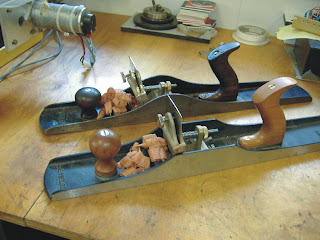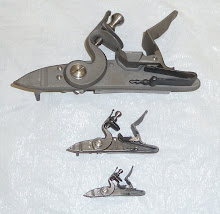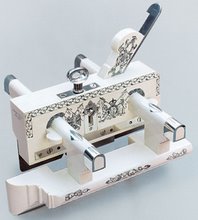
This was my first attempt at a metal scraper. It was a cut and paste from an old Shelton smoothing plane. With no casting equipment the brass frog and lever cap were fabricated out of brass stock. The frog was spring loaded with two springs and the long screw in front of the handle was used to adjust the stop of the frog thus changing the attack angle of the blade. It worked OK but needed some refinement.You do not usually think of a beader or scratch stock as a scraper but the cutter is a small scraper blade usually profiled or shaped for a special beading or inlay function. This was a special scraper made from an early style Stanley #3 smoother plane. The frog was made from aluminum angle stock bent to set the blade at roughly 80 degrees. You could install a thin scraper blade in the frog and use as a scraper or (as shown) install a beading cutter. With the installed side rod holding a fence from a Stanley 78 the plane was very useful as a beading tool and the handle and front knob provided a level of control not available with a Stanley beader.
Bottom view showing a beading cutter installed and the fence.
This scraper was my version of the poor mans 212. The going price was about $1200.00 for a Stanley 212 and Lie Nielsen
had not started producing the reproduction yet. I took an junk Stanley #2 , removed the frog and installed a piece of scrap iron found in a junk pile to where the frog had been attached . A hole was drilled to receive the adjustment rod . This prototype had two first in my toolmaking journey. First the frog and lever cap were investment cast from a wax pattern,second this was the first time I had used the spring to replace the front locking nut. This improvement was so effective I immediately converted every Stanley 12 and 212 scraper in the shop to this format.
The prototype 212 was so successful I made a pattern for sand casting using an original Stanley 212 for measurements. I had several hundred cast in ductile iron and later a few hundred cast in silicone bronze.These scrapers show up occasional at flea markets and auctions,the letters HT were cast into the body to enable one to distinguish it from an original Stanley 212.About half the sales were to collectors and
the others were bought by woodworkers like myself who could not afford the big bucks for a great user.
Almost all the scrapers sold to users were ordered with the modified spring adjuster.
Prototype of my patented scraper insert that was sold to Lee Valley. The prototype worked.
Lee Valleys production model.
I first made the "Jointer Scraper" about ten years ago using parts of a door hinge and some junk yard hardware.The plane body was a Craftsman #7 size jointer. The length of the scraper,patented spring blade adjustment,and the extra weight proved to be a winner. The scraper stayed loaned out more than in the shop for my own use. Everyone who saw it wanted one for their use. Because of the time to convert a plane and that it involved drilling and fitting a pin in the base casting it was not a good candidate to mass produce. The plane was loaned out several times to woodworkers who wanted to try and convert one of their extra planes. The problem was no one ever converted one and when I needed the plane I had to do a recall.One night while drinking some really bad Canadian beer I had the idea of how to make the insert without having to modify the plane.

Insert installed on a late model Stanley #7 and a Lie Nielsen.
For a recent product review HERE




No comments:
Post a Comment